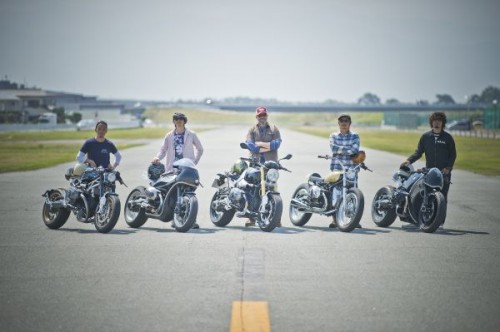The BMW Motorrad Days Japan – the biggest BMW Motorrad event in the country – were held at the Hakuba47 Mountain Sports Park on 30.-31,August. BMW Motorrad fans were not only treated to a wide range of exhibition stands but also round-the-clock entertainment. However, a particular highlight on the events stage came in the form of the premiere of four BMW R nineT motorcycles, each of which was the result of a unique custom conversion by leading Japanese customising firms.
Once the welcome and introductory speeches had been given by Florian Renndorfer, head of BMW Motorrad Asia, Pacific, Middle East, China and South Africa, it was the engine sound and the design of these four Custom R nineT that dominated the proceedings. Go Takamine (Brat Style), Kaichiroh Kurosu (Cherry’s Company), Shiro Nakajima (46 Works) and Hideya Togashi (HIDE Motorcycle) had all taken on the challenge to transform a BMW R nineT into an individual creation of their own design in less than 200 days.
Go Takamine‘s creation by the name of ‘Cyclone‘ was welcomed to the stage to thunderous applause, and was presented by no less a personage than the BMW Motorrad acrobat himself, multiple stunt riding world champion, Chris Pfeiffer. Go Takamine‘s interpretation of the R nineT was in the style of a so-called tracker bike, revealing a light-footed filigree character, crowned by an immaculate colour design and paintwork, not to mention numerous chrome components. In Go Takamine’s words, ‘This street bike is my attempt to combine the past with the near future, in the form of a modern, current motorcycle concealed beneath a nostalgic exterior.‘
The ‘Highway Fighter‘ from Kaichiroh Kurosu was the result of a fine stylistic mixture of both historic and current BMW motorcycle elements. Comparisons with the breathtakingly beautiful BMW R7 prototype from 1934 are fully justified, even though Kurosu‘s creation is essentially a machine that was made in modern production facilities with current styling. Kaichiroh Kurosu put it this way: ‘For me the object of the exercise was to look into the future. I imagined what BMW motorcycles might look like ten years from now, and I think that this would still be a pretty cool bike even if the traditional flat-twin engine were to be replaced by an electric motor.‘
In contrast, Shiro Nakajima‘s ‘Clubman Racer‘ was the result of one man’s passion for perfect riding machines, whether on the road or on the racetrack. In terms of lightweight construction and functionality, his interpretation of the R nineT followed on clearly from his previous projects, these largely having been developed for racing use. In the words of Shiro Nakajima, ‘What I wanted was to create something a bit more sporty than a cafe racer. A motorcycle that you don’t just take into an urban environment or ride over mountains with but one that you can also really enjoy on the racetrack. This was the reason why I chose above all to make it as light as possible.‘
Hideya Togashi‘s ‘Boxer‘, on the other hand, is a timeless variation in a classic sport design. Its fairing is reminiscent of the racing replicas of the nineteen seventies, bringing forth both memories and yearnings among motorcycling enthusiasts. Hideya Togashi himself told us, ‘The main feature is its slimline aluminium fuel tank. It seems to hug the rider, while the design of the fairing is borrowed from that of nineteen seventies racing models.‘
One person who attended the event who was particularly impressed with the creative talents of the four Japanese customisers was Ola Stenegard, head designer at BMW Motorrad of the R nineT. ‘I was absolutely bowled-over. I had high expectations – after all these are four of the best customisers in the world, and in the end I went down on my knees. What they have succeeded in creating here is just astounding. Interestingly, each of these bikes also reflects its creator. The ideas and innovations – just incredible and beautiful. The details – amazing. As I prefer to perform everything on my own motorcycles myself, we had many hours of discussions. About welding aluminium, sharpening metal and sand casting parts. There are so many reasons why I love their creations. Japan’s culture of customisation can be summed up like this – if you need a valve cap then let’s make one. Or if you want full body covering, why not just make it yourself? They don’t simply go out and buy parts. This attitude is somehow rooted in the culture of the Japanese craft trades and it is something I love. This is material for the next level and a perfect complement to the ‘first‘ R nineT family. It is something genuinely inspiring for us at BMW Motorrad. As well as for each and every R nineT owner.‘
via BMW


